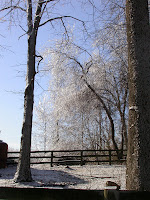 On Valentine’s eve in the Maryland suburbs of Washington D.C., I hoped for a snow storm in the knowledge that I would be able to have a romantic fire and reason to stay home the next day. What I got was thirty hours of no electricity, no water, no heat and no phone, as nature began the work of major tree pruning. The idea that beauty can be dangerous was made evident when my wife and I ventured forth to survey our winter wonderland. I note for the record, that today’s nor’easter in April has not inspired me to wish for two feet of snow, as I am a rather quick learn.
On Valentine’s eve in the Maryland suburbs of Washington D.C., I hoped for a snow storm in the knowledge that I would be able to have a romantic fire and reason to stay home the next day. What I got was thirty hours of no electricity, no water, no heat and no phone, as nature began the work of major tree pruning. The idea that beauty can be dangerous was made evident when my wife and I ventured forth to survey our winter wonderland. I note for the record, that today’s nor’easter in April has not inspired me to wish for two feet of snow, as I am a rather quick learn. 
The 2007 Valentine Day’s tree limb massacre was an expensive lesson, and like the seventeen year locust, which also prunes, a needed part of gardening even if I could have done without the stoking of a fireplace every forty five minutes for more than a day. But I digress.
Let me share with you some pictures, first of the beauty and then of the work. The ice covered brilliance was awe-some; the sound of limbs breaking was fear-some; the thought of man hours, mine, or cost, someone else to clean up was burden-some. The debris is still scattered, but mostly removed now some five hundred dollars later, just in time to cut the field for the first time hoping that I have picked up all the mower- destroying branch remains.
 No matter: pruning is a basic task of the well-tended, or not, garden. Her are a few tips:
No matter: pruning is a basic task of the well-tended, or not, garden. Her are a few tips:· Broadleaf Evergreen and/or deciduous trees and a few shrubs such as Japanese maples, witch hazel, rose of Sharon are pruned now as needed. This is mostly an aesthetic pruning. Note: needle evergreen trees such as spruces and pines will not recover from a hard pruning. Leave them alone, or only pinch out 1/3 of the new growth (called a candle) while still soft.
· Deciduous shrubs which flower on last year’s stems and bloom in early spring to early summer. Forsythia, lilac and oak-leaved hydrangea are a few examples. With forsythia, for example, you would remove about one third of the older stems to the ground which will encourage new blooms and stronger stem growth. Do this pruning immediately after the plant blooms.

· Flowering shrubs which bloom later but on last year’s stems and growth such as the traditional hydrangea--either prune in early spring which is better for the health of the plant but may reduce some flowering, or wait until they are finished blooming, and at once remove the flower heads, and as with the early bloomers remove about one third of the older branches.
· Flowering shrubs which bloom on new growth (current year’s growth). Some examples include butterfly bush and crape myrtle. Pruning maybe done when the leaf buds swell in the spring. Pruning will encourage new branch formation, and flowers will appear on new growth
 · Evergreen shrubs such as junipers and yews may be pruned after any chance of freeze through spring but not after August. Best to aim for mid- spring, whenever that may be. This year, 2007, we may skip mid-spring and go directly to summer, so as soon as the weather warms up and the there is sign of life would be acceptable.
· Evergreen shrubs such as junipers and yews may be pruned after any chance of freeze through spring but not after August. Best to aim for mid- spring, whenever that may be. This year, 2007, we may skip mid-spring and go directly to summer, so as soon as the weather warms up and the there is sign of life would be acceptable. As with all things, before you whack and cut, and shear and shape do some winter ice storm research and know your plants’ needs.
No comments:
Post a Comment